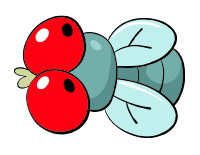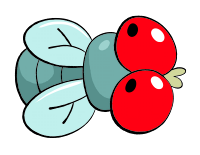FRIDAY THE 23rd, NOVEMBER 2018:
ANT DECAPITATORS

Alex Wild
Why our Flyday the 13th banner, if it's Friday the 23rd!? Obviously because this is Flyday's thirteenth entry...and the next proper Friday the 13th is almost a year away. Today also marks Flyday's return after a hiatus of almost eight weeks, and November is second Halloween here on bogleech.com. For all of these reasons, I wanted to do something special here, so we're going to talk about two closely related, slightly different flies that do something extra grisly to their victims!
Pseudacteon is another genus of the wildly successful, wildly diverse little Phorid flies, and have become fairly famous around the internet in "scary nature" clickbait lists. These tiny creatures specialize in parasitizing ants, and particularly fire ants, which has earned them some attention as a possible control mechanism of the highly invasive and venomous lawn pests.

Sanford D. Porter
The fun begins when a female Pseudacteon catches scent of a foraging worker ant, exposed and vulnerable outside of her colony. Hovering for a moment over her chosen victim, she plunges out of the air like a predatory hawk with pin-point accuracy, stabbing her sharp ovipositor straight into a seam in the ant's exoskeleton for only a split second. Different species have different ovipositor shapes, seen here, perfectly adapted to suit their preferred host species, and the fiend is already flying out of reach by the time the ant can so much as turn around to react.

Sanford D. Porter
Immediately upon hatching, the microscopic fly maggot makes its way into the worker ant's head, and begins to feed on the host's hemolymph, not yet causing any actual damage. Only when the maggot is ready to pupate does it begin to consume the ant's actual brain, which unfortunately does not outright kill its victim. While the brain of an insect is actually fairly sophisticated and capable of some conscious decision making (a fact that we actually discovered in flies first) the bodies of many insects can indeed behave "autonomously" even with most or all of the brain missing, and our brainless ant will begin to wander in aimless directions for up to a month, preferably (for the safety of the parasite) far away from the rest of the colony.
A couple of weeks in to this undead rambling, the maggot will secrete a chemical weakening the connective tissues of the ant's neck...and cause its head to drop right off.

Sanford D. Porter
The parasite's weird adaptations don't end there, either. Shortly before pupating, the larva will push out the ant's old mandibles and other feeding appendages, usually with enough force to break them off. This ensures that the pupa can more neatly block off the ant's old mouth opening with the dark, hardened plates you can clearly see in these first two pupae, and you'll also notice what look like two short little "antennae" protruding from the pupa's sides. These are actually its breathing tubes, and you can see how they protrude through the underside of the ant skull in the third specimen.

Sanford D. Porter
The pupa develops for about another two weeks, a monstrous embryo sleeping and breathing inside a severed head, until...BOOP! The adult fly pops right out of the mouth! Hi, pseudacteon!!!
Interestingly, the sex of the adult fly seems to be determined by the size of the ant head, with females developing by necessity in larger ant skulls!

Brown B, Kung G, Porras W
That's all fairly spooky, and I especially like the part where the brainless ant goes for a walk, but a related group of phoridae has traded the spookiness for sheer brutality. This fly is the genus Dohrniphora, and just look at that proboscis! It's IMMENSE! What's she even do with that!? You're gonna love the answer!

Brown B, Kung G, Porras W
Dohrniphora doesnt bother injecting her eggs into a host. Instead, she follows the scent of ants that are already injured, specifically the ferocious trap jaw ants, which have a tendency to get into fights amongst themselves. Both the male and female fly will often show up together to a trap jaw battlefield, feed together on ant blood and get some mating in before the male high-tails it out of there.
The female, however, will hang around a while longer, picking herself out an ant too weak to fight back against her.
Using the proboscis exactly like a hacksaw, the fly shreds through the wounded soldier's neck in just seconds, and in a feat of fairly rare strength for a fly, she grabs the relatively massive head by a mandible or an antennae and simply runs away with it.
We actually don't know exactly what she does next, as this behavior has only recently been discovered at all. She doesn't seem to use the head as a larval incubator like her parasitic cousins, and it may simply be that she continues to feed on it herself, using the extra protein as a mosquito does to manufacture massive numbers of eggs.
The real question, of course, on all of our minds by now, is which of these two head hunters is darker. On the one hand, you've got a brain-eating alien that turns its host into a walking corpse...but on the other hand, you've got a miniature angel of death that comes to collect the skulls of fallen warriors. It's the ultimate showdown; Zombie body horror versus Supernatural Slasher Horror!


